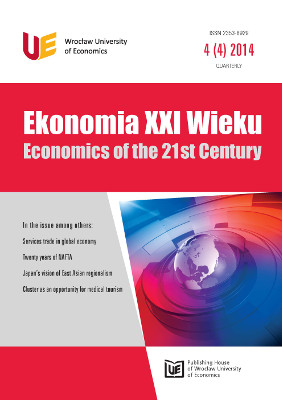Japan’s vision of East Asian regionalism − toward soft balancing strategy
Japan’s vision of East Asian regionalism − toward soft balancing strategy
Author(s): Sebastian BobowskiSubject(s): Economy
Published by: Wydawnictwo Uniwersytetu Ekonomicznego we Wrocławiu
Keywords: Japan; East Asian regionalism; soft balancing strategy
Summary/Abstract: East Asia is undoubtedly the region of unprecedented scale of dynamism of events, both in the economic and political terms. Growing economic power of China is nowadays a serious threat to the traditional regional diplomatic leadership of Japan, which has internal problems. Mutual distrust boosted by historical resentment contributed to the constitution of competing visions of East Asian regionalism, drawing, on the one hand, on the realm of values as the foundation of a common identity, and solidarity, on the other, on different concepts of membership of the Southeast, and South Asian countries, including the representatives of Oceania. Promoted through the path of soft diplomacy, Japanese vision of a broad community, involving, in addition to ASEAN, democratic countries of the South and Oceania, built on the foundation of universal values of the Western world, provided a natural counterbalance to the narrower, more conservative, strictly Asian concept of China. The involvement of the core of ASEAN, namely Singapore, Vietnam, Malaysia, Japan, South Korea, Australia, and New Zealand, together with Canada, Mexico, Chile and Peru in the Trans-Pacific Partnership, is confronted with Chinese counter-proposal in the form of Regional Comprehensive Economic Partnership, which indicates that the soft strategy game has gone up to a higher level. The coming years will resolve the dilemma which vision of economic regionalism is more attractive and vital. The expected breakthroughs include, in particular, the conclusion of a trilateral China–Japan–the Republic of Korea free trade agreement, the implementation of the ASEAN Economic Community, the intensification of discussions around the RCEP project, and finally – the evolution of ambivalent, so far, Chinese stance towards TPP project. In the case of the latter, it is critical to observe the dialogue between China and ASEAN at the sectoral level, initiated in 2011, implementation of the Foreign Investment Protection Agreement concluded with Canada in 2012, and finally − negotiations on the free trade agreement with Australia. Undoubtedly, narrow Asian formula of regionalism in East Asia has lost its importance in the face of both intraand extra-regional challenges.
Journal: Ekonomia XXI Wieku
- Issue Year: 2014
- Issue No: 04
- Page Range: 80-91
- Page Count: 12
- Language: English

